[Retracted] The Mathematical Analysis of the New Fractional Order Ebola Model
Abstract
This research study focuses on the analytical behavior and numerical computation of the fractional order Ebola model. In this study we have calculated the conditions for the existence, uniqueness, and stability of the solution with the help of the fixed point results. In addition to this, we calculated the numerical solution of the fractional order smoke model with the help two-step fractional Adam’s Bashforth method using the Caputo’s fractional derivative of order μ. Furthermore, the results obtained for different orders of the fractional derivative μ have been shown graphically with the help of Matlab.
1. Introduction
The concept of fractional calculus (FC) was raised in seventeen century from famous correspondence between Leibniz and L’Hoptial. In the consequences of aforementioned correspondence, Leibniz wrote a letter to Guillaume de L’Hôpital that what will be the half order derivative of dependent variable y w.r.t x, i.e, d1/2x/dy1/2. In the response, he wrote that this will bear some useful consequence in near future. Later on, it was traced that fractional calculus was introduced by Abel in one of his papers, where the author discussed the idea of fractional-order derivatives (FOD), fractional-order integration (FOI), and the mutual inverse relationship between them [1]. In 1832, one of the greatest French mathematicians (of his era) Liouville presented the definitions for the fractional derivative and fractional integration named as Riemann-Liouville fractional derivative and integration [2]. Later, on in 1890, Heaviside practically used the fractional differential operator in electrical transmission line analysis circa [3]. Recently, the researchers of the 19th and 20th century have made their significant contributions to introduce new definitions of fractional differential and integral operators and in the study of the practical applications of FC [4].
In modern era, the uses of FC in various engineering problems have been raised [5–7] 2014). For instance, FC has various applications in different diffusion phenomenon including heat transfer, gaseous exchange, and water transfer through permeable materials [8–11]. Bagley and Torvik presented FC as an instrument for displaying tissue viscoelasticity during the 1980s (Uchaikin, 2013). Study of intricacy gives another view to a few genuine wonders which appeared to be odd, and during the most recent years, new strategies have been utilized to separate secret properties of complex frameworks [12]. Further, a variety of FC tools have been widely used in several complex phenomena [13–15]. In some circumstances, FC has been perceived for taking care of issues in viscoelasticity, electrochemistry, and dispersion [16–19]. A few analysts featured FC as a tool for examination of complex phenomenon by bringing the techniques of FC and its applications to a more extensive crowd [20, 21] .
The technique by which a real world problem is described in mathematical concepts or language is known as mathematical modeling [22]. Mathematical modeling of infectious diseases has been the main focus for the scientists and researchers over the last two decades. Mathematical modelers used to model the infectious diseases in the form of mathematical models consist of classical differential equations (CDEs). Recently, the researchers have diverted their focus to model the diseases in the form of fractional differential equations (FDEs) which has the potential to describe the real world phenomena more accurate and considered reliable as compared to the conventional derivatives. FDEs are global in nature, more realistic, and give great degree of freedom to modelers as compared to the CDEs. Modeling via FDEs has produced highly influential results in the investigation of transmission of the infectious diseases models [23, 24].
In the year 1976, a flare-up occurred in African nation of the Democratic Republic of Congo (DRC), which was then termed after the name of the lake “Ebola” flows near to the DRC. The infection has five sorts, four out of these five spread illnesses in people. The infection use to attack on the immune system which then cause internal bleeding and affect each organ of the individuals. This terrifying infection spread by contacting directly with the tainted individuals either via body fluids or direct skin contact. The infection can also be pass through connection with the creatures like monkeys, etc. Nonetheless, the infection cannot be transmit through air and food. Later on, in 2013, the infection arose in Guckduo and Guinea, where 28,616 casualties were reported, and out of these casualties, 11,310 lost their lives. Today, where the advanced world is confronting another pandemic flare-up as COVID-19, the investigation of such irresistible sicknesses is still a center of focus for the researchers [25].
2. Model Formulation
- (i)
: the first class of the model has been named as susceptible class. This class contains individuals who have no symptoms or any infection of the disease but can be attacked by the virus
- (ii)
: the second class of the population has been named as exposed class. This class contains individuals who have been attacked by the virus but not yet shown the symptoms of the infection or not yet infectious
- (iii)
: this is the third class of the population containing individuals who have been attacked by the virus and are being able to transfer the disease to not yet attacked individuals of the populations
- (iv)
: this class has been named as vaccinated class containing those individuals of the susceptible class who have been vaccinated against the virus
- (v)
ℝ: this class is the recovered class which contains those individuals who have survived the disease
- (i)
: an individual of the population move to the population through the rate τ1
- (ii)
: an individual of the class joins the class with the rate β after getting infectious
- (iii)
: the given parameter is used for the rate of the vaccination which transfer an individual from to
- (iv)
: the rate of transfer of the individuals from to ℝ after surviving the disease
(1)
The paper has been organized as follows: the first section of the paper contains introduction. The second section has been restricted to the formulation of the model, while the third section has been devoted to the preliminaries. The fourth section of the paper contains the existence and uniqueness of the solution of the model. The fifth section of the paper includes the stability of the solution, while the sixth section contains qualitative study where we formulated the disease free, disease endemic, and basic reproduction number R0 and then test the stability of the R0 locally with the help of theorems. In the seventh section, we have formulated the numerical solution of the model via Adam’s Bashforth scheme, and the eighth section contains the numerical simulation of the results obtained in the section seventh. At last, we have concluded our work in the conclusion section.
3. Preliminaries
In this section of the present article, we provide some basic definitions, theorems, and results that will be used and fruitful in understanding the rest of the article.
Definition 1. (see [26].)The Caputo’s fractional differential operator of any arbitrary order μ > 0 is defined as
Lemma 2. (see [27].)“The following result holds for fractional differential equations
for arbitrary αi ∈ R, i = 0, 1, 2, 3, ⋯, m − 1, where m = [μ] + 1 and [μ] symbolizes the integer part of μ”.
Lemma 3. (see [28].)Let θ ∈ ACn[0, T], μ > 0, and n = [μ], then the following result holds
Lemma 4. (see [28].)In view of Lemma 3, the solution of , n − 1 < μ < n is given by
where cj ∈ R.
Definition 5. (see [26].)Suppose we have Caputo’s fractional differential equation of order μ
then the solution is given as
where represent the remainder term. For the study of convergence and uniqueness of the solution of the scheme, we refer to ([26]).
Theorem 6. (see [29].)“Let X be a Banach space and is compact and continuous, if the set,
is bounded, then has a unique fixed point.”
4. Existence of the Solution
To prove the existence of the solution, we make the following assumptions:
Theorem 7. When the assumptions (P1) and (P2) are true, it verifies that the problem (13) has at least of one fixed point which also implies that the problem of our study has also at least one solution.
Proof. Furthermore we proceed as.
Step 1. First, we have to show that is continuous. To acquire the results, we suppose that is continuous for j = 1, 2, 3, 4, 5, 6. Which implies that is also continuous. Assume θn.θ ∈ X∋θn⟶θ, we must have .
For this, we consider
As is continuous, therefore , yields that is continuous.
Step 2. Now, to prove that is bounded for any , we make of the supposition that satisfies the growth condition:
Here, we assume a , the subset of with the property of boundedness, and we need to prove that is also bounded. To reach our destination, we assume that for any , now as is bounded, so ∃Kq ≥ 0∋
Further, for any by using the growth condition, we have
Therefore, is bounded.
Step 3. Here, we attempt to prove that the operator we defined is equicontinuous, for this we assume that t2 ≤ t1 ∈ J = [0, T], then
By taking advantage of Arzelà-Ascoli theorem, we can say that is relative compact.
Step 4. In this step, we need to prove that the set defined below is bounded
To prove this, we suppose that θ ∈ E, ∋ for each t ∈ J, where J = [0, T] we have
From here, we can claim that the set defined above is bounded. By using Schaefer’s FPT, the operator we defined, i.e., has atleast one fixed point, and hence, the model we studied in this paper has at least one solution.
Theorem 8. The problem (13) is unique solution, if .
Proof. Let , then
Hence, we can say that the fixed point is unique, and therefore, our solution is unique.
5. Stability Results
To prove that the solution of the considered model is stable, we use the concept of Ulam and Ulam Hyer stability. To get the desired results we proceed as
Definition 9. (see [27].)Equation (26) has UH-stability, if for ς1 > 0 and assume any solution for the inequality given by
Definition 5.2. “If ∃ϑ ∈ C(R, R) with ϑ(0) = 0, ” for unique result and any solution of equation (26) ∋
then equation (26) has GUH-stability.
Remark 10. (see [27].)“If ∋, then satisfies (27) if
(i)
(ii) ”
For further analysis, we suppose that the following is the solution of the perturbed problem of (13)
Lemma 11. The result stated below holds true for equation (30),
Theorem 12. By making use of Lemma 11, the solution of the problem (13) is UH-stable as well as GUH-stable, if TμLω/Γ(μ + 1) < 1.
Proof. Assume be any and unique solutions, respectively, problem (13), then
From here, we claim that the solution of (13) is UH and GUH stability if
Such that Y(0) = 0.
Definition 13. The UHR-Stability of (26) is ensured for g∗ ∈ C([0, T], R), if for ς1 > 0 and assume θ ∈ X be any solution of the inequality expressed by
∃ a unique solution of (26) with ∋
Definition 14. (see [27].)“For g∗ ∈ C[0, T], R], if ∃ and for ς1 > 0, consider that θ be any solution of (34) and be any solution of (26) ∋
Remark 15. If ∃, then for (27) holds, if
- (i)
- (ii)
Lemma 16. The stated result below holds true for (30)
Proof. The proof has been left for the readers.
Theorem 17. With the help of Lemma 16, our solution is Ulam and Generalized Ulam stable if TμLθ/Γμ + 1 < 1.
Proof. . Assume be two solutions such that θ is any and any and is the unique solution of our problem, then
Hence, the solution possesses both type of the stabilities.
6. Qualitative Study
In this section of the article, we present disease free equilibrium, disease endemic equilibrium, the basic reproduction number R0, and the local assymptotical stability of the R0. To proceed, we first find the disease free equilibrium and disease endemic equilibrium of the model. The disease free equilibrium is given as S0 = (Λ/d0 + ψ, 0, 0, 0, 0), while the endemic equilibrium is given below.
6.1. Endemic Equilibrium
6.2. The Basic Reproduction Number
Clearly, the eigen values are (say) λ1 and λ2 which are given as and . Therefore, the basic reproduction number R0 = max(λ1, λ2).
Theorem 18. The basic reproduction number R0 is locally assymptotically stable at the disease free equilibrium point that is stable if R0 < 1.
Proof. For this purpose, we construct the following Jacobian.
Now, let the eigen values are (say) λ1, λ2, λ3, λ4, λ5. Clearly λ1 = λ2 = −d0, λ3 = τS0 − (d0 + d1 + κ), λ4 = −(d0 + ψ), and . From λ3, we have , and from λ5, we have . Therefore, R0 = max(λ3, λ5) < 1 and hence is locally assymptotically stable at the disease free equilibrium point.
Theorem 6.2. The basic reproduction number R0 is locally assymptotically stable at the endemic equilibrium point if R0 > 1.
Proof. The proof of this result can be obtained on the same manner as the proof in [30].
7. Numerical Solution
And , , , , and are the remainder’s terms.
8. Numerical Simulation
In this section of the article, we present the graphical results of the solution obtained in (54). For this purpose we have simulated the results via Matlab by assigning the values given in (Table 1) to the parameters and classes of the model. The graphical results are shown in the following.
| Parameters | Physical description | Numerical value | Source |
|---|---|---|---|
| Λ | The birth rate | 0.4 | Assumed |
| d0 | Natural death rate | 0.7 | Assumed |
| d1 | Disease death rate in | 0.075 | Assumed |
| d2 | Disease death rate in | 0.35 | Assumed |
| τ | The contact rate of and | 0.14280 | Assumed |
| κ | The transference rate from to | 0.048 | Assumed |
| β | The contact rate of and | 0.35 | Assumed |
| ξ | Recovery rate | 0.53 | Assumed |
| ψ | Vaccination rate | 0.00493 | Assumed |
9. Discussion
Figure 1 describes the dynamics of susceptible population for different values of the order of fractional derivatives. Each curve tends to the equilibrium solution irrespective of the value of μ. As we increase the value of μ, the rate of convergence to the stated equilibrium increases. Figure 2 represents the behavior of E(t) along the time direction, and the figure shows that for describing the slow evolution of disease, one might assume small values of μ. Infection from the community could be rapidly eliminated by increasing the order of the derivative as shown in Figure 3. A similar conclusion could be drawn from Figures 4 and 5, i.e., to capture the realistic scenario of slowly spreading diseases, one must consider the tools of fractional order derivative while modeling such epidemics.
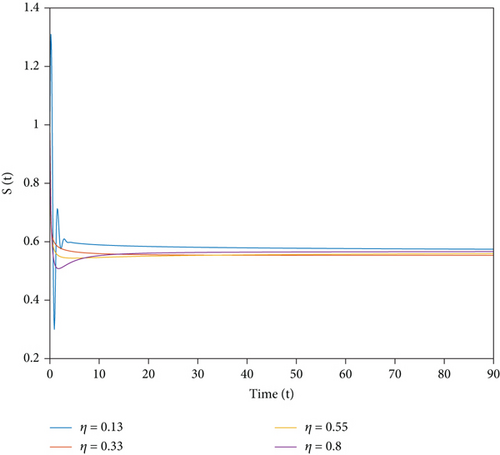
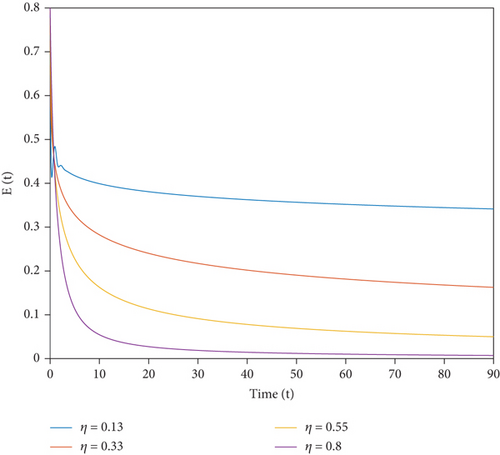
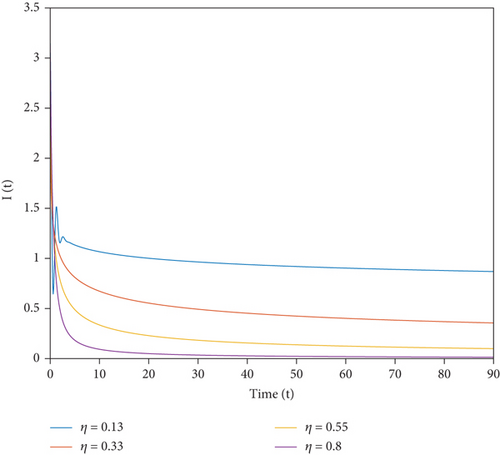
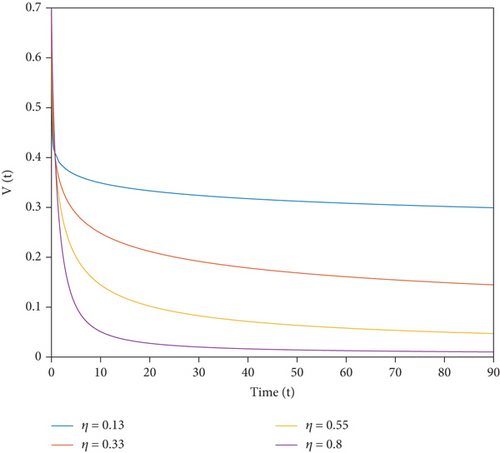
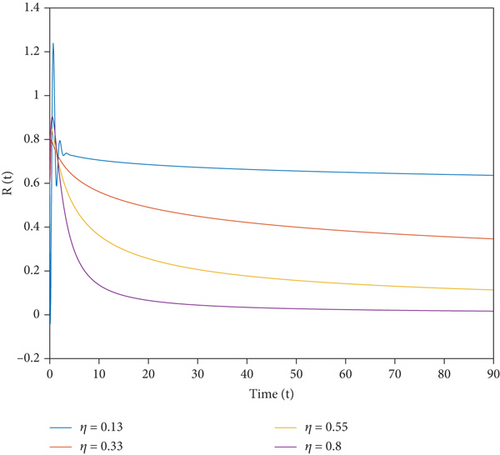
10. Conclusion
In this paper, we have studied the fractional order Ebola model containing Caputo’s fractional derivative of order μ. The paper contains the study related to the existence of the solution performed by using theorems of fixed point theory for the existence of fixed point. In addition, we have proved that the solution of the system is unique as well as Ulam stable. Apart from this, we have find the numerical solution of the studied model with the help of two-point fractional order Adam’s Bashforth method presented for the approximation of the fractional differential equations containing the Caputo’s fractional derivative. In addition, we have visualized the results graphically with the help of Matlab. At last, we have discussed the dynamical behavior of the obtained solution for all classes of the said model.
Conflicts of Interest
The authors declare that they have no conflicts of interest.
Open Research
Data Availability
The data will be for public after the publication.




